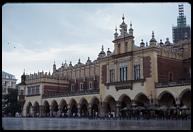

|
Poland |
Poland was the only East-block country in which farming was not collectivized. Farmers retained control and ownership of their land. Ironically, it is a free-market economy that now risks pushing many of them off their land, as modern farming techniques and economies of scale make their individual plots of land uncompetitive. As Rosalba and I cycled through the country, almost all of which is farmed, we saw everything from horse-drawn wooden carts filled with hay to the latest John Deere threshers.
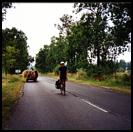
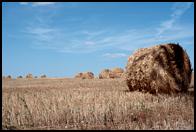
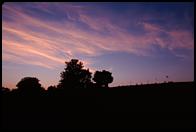

Sometimes, though, it is good to just forget the politics and social issues, and take a look around at the scenery.
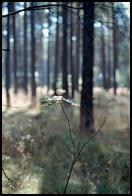

Some of the details can be neat, too.
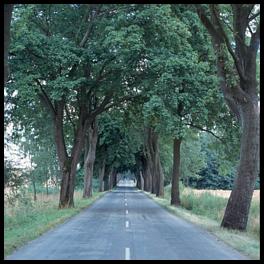
Road surface in Poland is often bad, and if you're looking for challenging climbs or exciting descents, you pretty much need to find yourself another country. Rosalba certainly did not seem to enjoy the vast expanses of flat, hot countryside. I, however, found the long, straight roads rather soothing, a kind of meditative experience. Many of them are shaded by trees; on one or two occasions we found ourselves in veritable topiary tunnels.
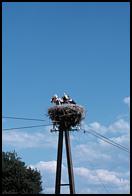
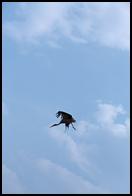
I had never seen storks before, but now I can understand why they're the bird chosen to "deliver" babies. They are beautiful birds, slow and graceful in flight. Unfortunately, it's hard to carry a long telephoto lens on a bicycle trip.
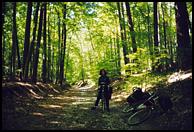
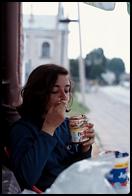
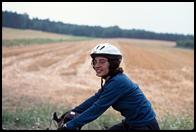
Rosalba, ever opposed to being photographed, was almost more elusive than the storks. But after a while I learned how to shoot pictures on the go, while riding, and how to pretend to be fumbling with camera maintenance while I was really setting up exposure and focus for a surprise shot. Unfortunately for my stork pictures, I never did figure out how to climb up a telephone pole.
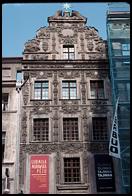
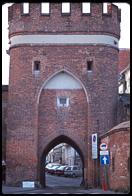
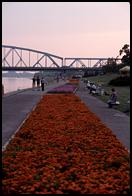
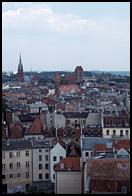
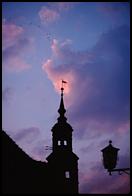
Torun was the birthplace of Nicolas Copernicus. Like Bergen in Norway, it was associated with the Hanseatic League; the effect of this ancient wealth is easily visible in the splendid facades that make almost every other building in the historic center a work of art. If you get tired of the gothic architecture or the picturesque little alleys or the imposing medieval ramparts, there's always the option of a walk among the flowerbeds on the banks of the Wisla River. Torun is probably the most charming place we saw in Poland.

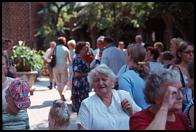

Apparently, some years ago the Madonna appeared to someone in the little village of Stary Lichen and left her footprints in a rock. Today the rock is enclosed in a church, and there are so many pilgrims that we just could not get inside to take a look.
Nearby, donations from the faithful are funding construction of Poland's biggest church, which is in fact the biggest church built in the twentieth century and one of the top ten or so biggest churches in the world. From a purely architectural perspective, the place is a disappointment---just a modern copy of classical basilicas like St.Peter's in Rome. I also wonder about the wisdom of spending millions on building a huge church on farmland in the middle of nowhere, far from major cities or airports.
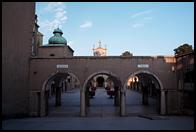
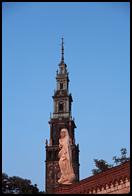
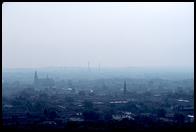
Crowded as it is, Stary Lichen is just a minor place of worship compared to Czestochowa, Poland's spiritual center. The Paulite monastery on top of the hill called Jasna Gora contains an icon of the Black Madonna, venerated as "Queen of Poland." The fact that the monastery was one of the few places in Poland to withstand a 17th century Swedish invasion was of course attributed to a miracle of the Madonna. Today, the chapel containing the icon is lined with thousands of medallions, crucifixes, casts, crutches, walking sticks, and other gifts from people who feel they have been healed by her.
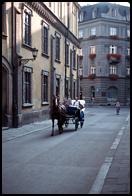
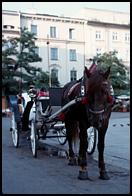
To be a dumb tourist or not to be a dumb tourist? I was almost tempted by a "romantic horse and carriage ride" around Krakow, but then I figured that a bicycle is probably cheaper.
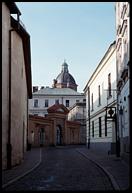
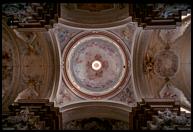
There are many impressive churches in Krakow. A handful are gothic, but most of the ones we saw are baroque. I was surprised to learn that several of them are based on the design of Sant'Andrea della Valle, a famous baroque church in Rome that is only a few minutes' walk away from where I used to live.
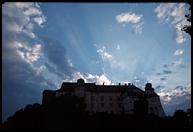
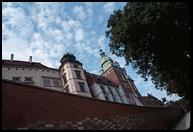
Wawel is a small fortified hill at the southern end of Krakow, topped by a large castle and a magnificent cathedral. For centuries, the castle was the residence of Polish kings. The cathedral is where the kings were crowned and where they are now entombed, together with military heroes, distinguished artists, and other notable Poles.
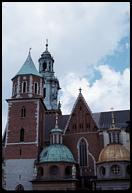
Wawel is probably the gem of Poland's rapidly growing tourist industry. The lines to get in were huge, not unlike, say, the Vatican Museums in Rome or van Gogh mania at Boston's MFA. But the organizers had some pretty good ideas. The castle, for instance, was enlivened by chamber ensembles playing period music: much better than your average medieval castle museum..
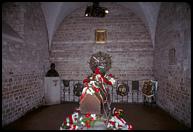
General Jozef Pilsudski led the Polish Legions in World War I and then ruled Poland during a period of independence and relative prosperity between the two World Wars. Half a century later, fresh flowers and ribbons still adorn his tomb, which lies beneath Wawel Cathedral. With a touch of typically Slavic drama, not all of his body is in the crypt: his heart lies elsewhere, buried at the foot of his mother's grave.
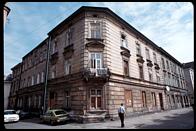
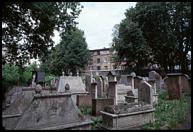
Drama of a different kind is still almost palpable in Kazimierz, the old Jewish quarter. Seventy thousand people lived here in 1939; none were left five years later. Today only about a hundred Jewish people live in Kazimierz. The High Synagogue is closed, as it has been since World War II. A nearby museum provides many details about Jewish customs, and documents the destruction of the local population with frightening photos and a lot of original paperwork in German and Polish.
I was completely unprepared for some of the bitterness I encountered. I entered a synagogue, and silently gave the man in charge 2 zl, as requested by the sign at the entrance. Then, evidently judging by my English guidebook, and not knowing that I speak Polish, he turned to his partner, who was eating lunch in the other room, and complained: "Look, they go away to America, and then they come back and all they give us is change." I didn't know what to think.
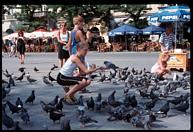
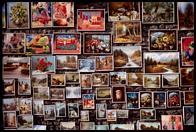
When things become too depressing, one can always wander back to Rynek
Glowny, the main square, for a little people (and pigeon) watching.
Enterprising roadside stands sell pigeon feed (karma dla golebi) to
little kids. Or one can walk to a street nearby and take a look at
some of the art that hangs on the walls.
Go on to the slide show from the Czech Republic.
| Top |